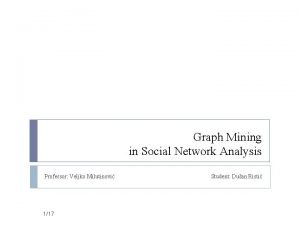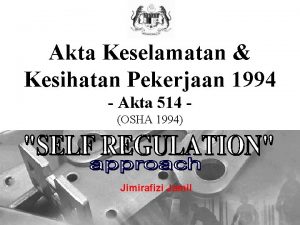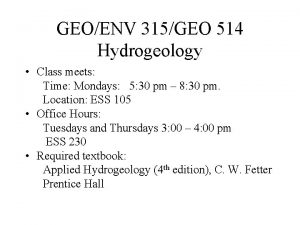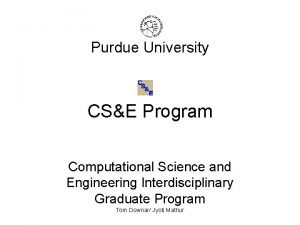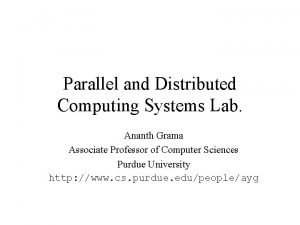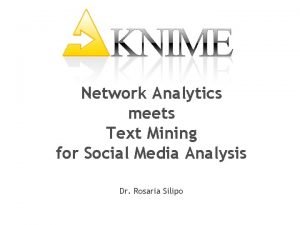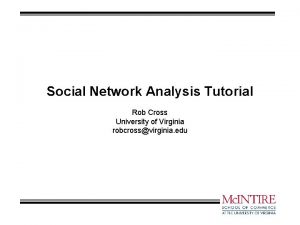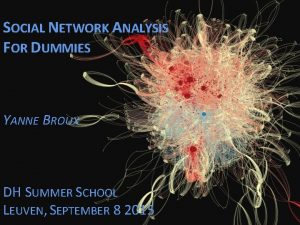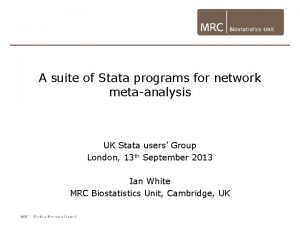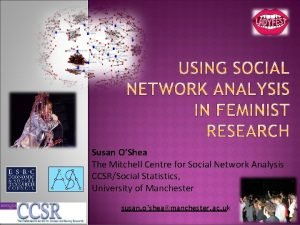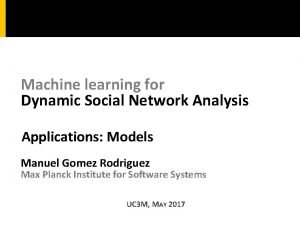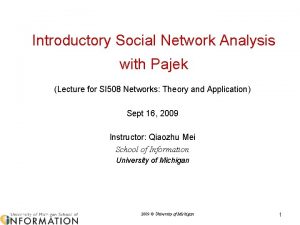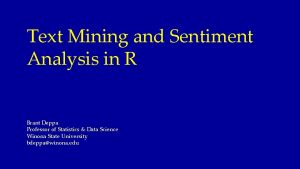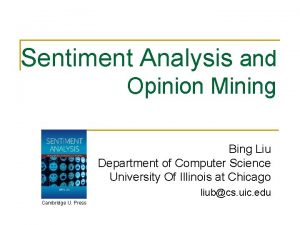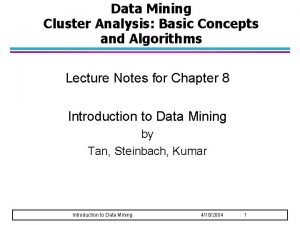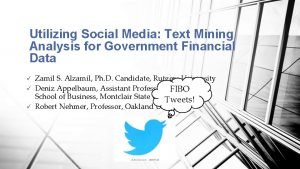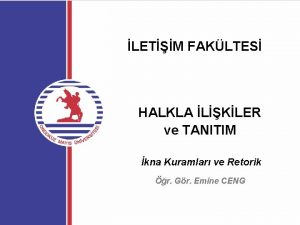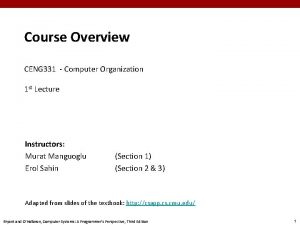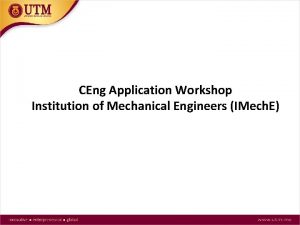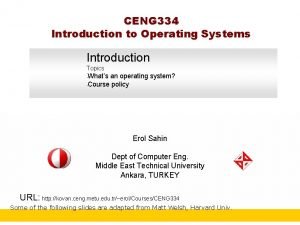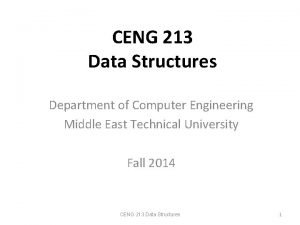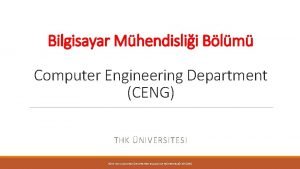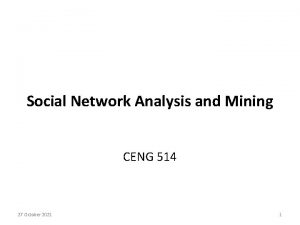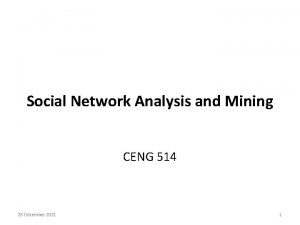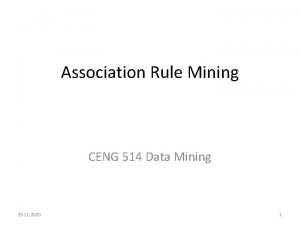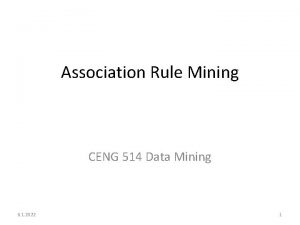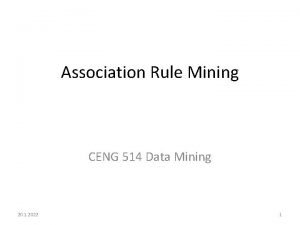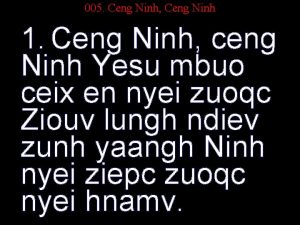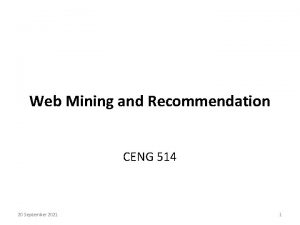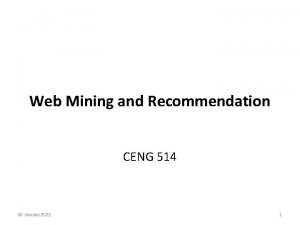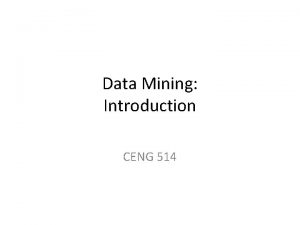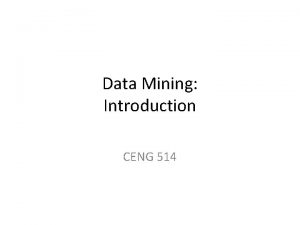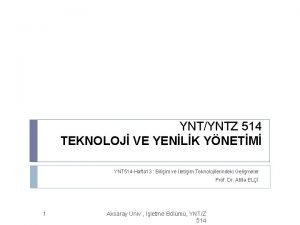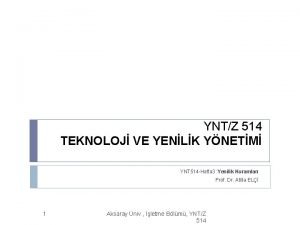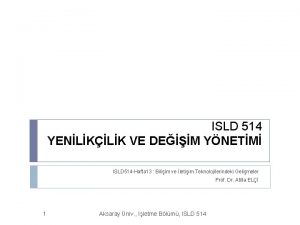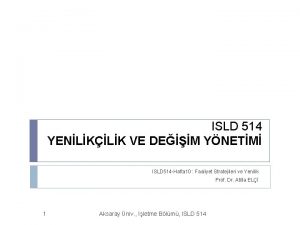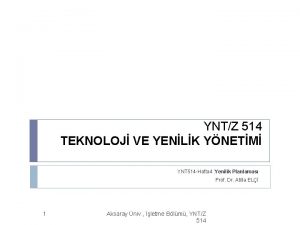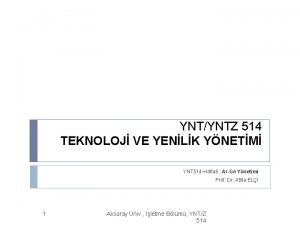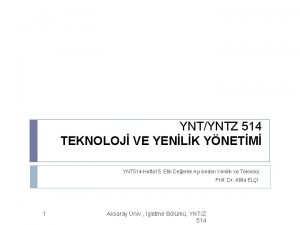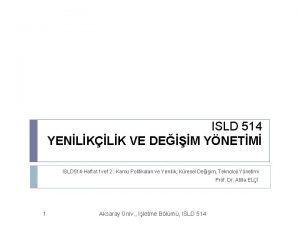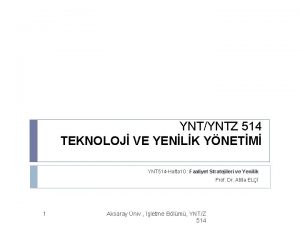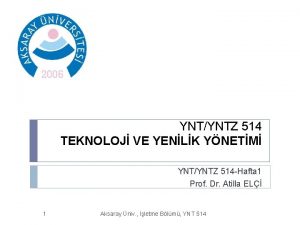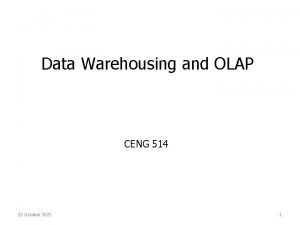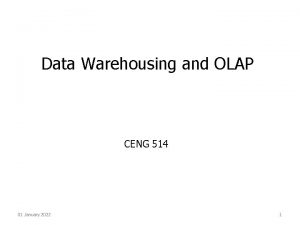Social Network Analysis and Mining CENG 514 11



































- Slides: 35

Social Network Analysis and Mining CENG 514 11 December 2021 1

Social Network Analysis • Social Network Introduction • Statistics and Probability Theory • Models of Social Network Generation • Mining on Social Network 11 December 2021 2

Society Nodes: individuals Links: social relationship (family/work/friendship/etc. ) S. Milgram (1967) Six Degrees of Separation John Guare Social networks: Many individuals with diverse social interactions between them. 11 December 2021 3

Communication networks The Earth is developing an electronic nervous system, a network with diverse nodes and links are -computers -phone lines -routers -TV cables -satellites -EM waves Communication networks: Many non-identical components with diverse connections between them. 11 December 2021 4

“Natural” Networks and Universality • Consider many kinds of networks: – social, technological, business, economic, content, … • These networks tend to share certain informal properties: – large scale; continual growth – distributed, organic growth: vertices “decide” who to link to – interaction restricted to links – mixture of local and long-distance connections – abstract notions of distance: geographical, content, social, … • Do natural networks share more quantitative universals? • What would these “universals” be? • How can we make them precise and measure them? • How can we explain their universality? • This is the domain of social network theory • Sometimes also referred to as link analysis 11 December 2021 5

Some Interesting Quantities • Connected components: – how many, and how large? • Network diameter: – maximum (worst-case) or average? – exclude infinite distances? (disconnected components) – the small-world phenomenon • Clustering: – to what extent that links tend to cluster “locally”? – what is the balance between local and long-distance connections? – what roles do the two types of links play? • Degree distribution: – what is the typical degree in the network? – what is the overall distribution? 11 December 2021 6

A “Canonical” Natural Network has… • Few connected components: – often only 1 or a small number, indep. of network size • Small diameter: – often a constant independent of network size (like 6) – or perhaps growing only logarithmically with network size or even shrink? – typically exclude infinite distances • A high degree of clustering: – considerably more so than for a random network – in tension with small diameter • A heavy-tailed degree distribution: – a small but reliable number of high-degree vertices – often of power law form 11 December 2021 7

Some Models of Network Generation • Random graphs (Erdös-Rényi models): – gives few components and small diameter – does not give high clustering and heavy-tailed degree distributions – is the mathematically most well-studied and understood model • Watts-Strogatz models: – give few components, small diameter and high clustering – does not give heavy-tailed degree distributions • Scale-free Networks: – gives few components, small diameter and heavy-tailed distribution – does not give high clustering • Hierarchical networks: – few components, small diameter, high clustering, heavy-tailed • Affiliation networks: – models group-actor formation 11 December 2021 8

Models of Social Network Generation • Random Graphs (Erdös-Rényi models) • Watts-Strogatz models • Scale-free Networks 11 December 2021 9

The Erdös-Rényi (ER) Model (Random Graphs) • All edges are equally probable and appear independently • NW size N > 1 and probability p: distribution G(N, p) – each edge (u, v) chosen to appear with probability p – N(N-1)/2 trials of a biased coin flip • The usual regime of interest is when p ~ 1/N, N is large – e. g. p = 1/2 N, p = 1/N, p = 2/N, p=10/N, p = log(N)/N, etc. – in expectation, each vertex will have a “small” number of neighbors – will then examine what happens when N infinity – can thus study properties of large networks with bounded degree • Degree distribution of a typical G drawn from G(N, p): – draw G according to G(N, p); look at a random vertex u in G – what is Pr[deg(u) = k] for any fixed k? – Poisson distribution with mean l = p(N-1) ~ p. N – Sharply concentrated; not heavy-tailed • Especially easy to generate NWs from G(N, p) 11 December 2021 10

The Clustering Coefficient of a Network • Let nbr(u) denote the set of neighbors of u in a graph – all vertices v such that the edge (u, v) is in the graph • The clustering coefficient of u: – let k = |nbr(u)| (i. e. , number of neighbors of u) – choose(k, 2): max possible # of edges between vertices in nbr(u) – c(u) = (actual # of edges between vertices in nbr(u))/choose(k, 2) – 0 <= c(u) <= 1; measure of cliquishness of u’s neighborhood • Clustering coefficient of a graph: – average of c(u) over all vertices u k=4 choose(k, 2) = 6 c(u) = 4/6 = 0. 666… 11 December 2021 11

Case 1: Kevin Bacon Graph • Vertices: actors and actresses • Edge between u and v if they appeared in a film together Kevin Bacon No. of movies : 46 No. of actors : 1811 Average separation: 2. 79 Is Kevin Bacon the most connected actor? NO! 11 December 2021 876 Kevin Bacon 2. 786981 46 1811 12

#1 Rod Steiger #876 Kevin Bacon Donald #2 Pleasence December 2021 #3 11 Martin Sheen 13

World Wide Web Nodes: WWW documents Links: URL links 800 million documents (S. Lawrence, 1999) ROBOT: collects all URL’s found in a document and follows them recursively 11 December 2021 R. Albert, H. Jeong, A-L Barabasi, Nature, 401 130 (1999) 14

Scale-free Networks • The number of nodes (N) is not fixed – Networks continuously expand by additional new nodes • WWW: addition of new nodes • Citation: publication of new papers • The attachment is not uniform – A node is linked with higher probability to a node that already has a large number of links • WWW: new documents link to well known sites (CNN, Yahoo, Google) • Citation: Well cited papers are more likely to be cited again 11 December 2021 15

Scale-Free Networks • Start with (say) two vertices connected by an edge • For i = 3 to N: – for each 1 <= j < i, d(j) = degree of vertex j so far – let Z = S d(j) (sum of all degrees so far) – add new vertex i with k edges back to {1, …, i-1}: • i is connected back to j with probability d(j)/Z • Vertices j with high degree are likely to get more links! • “Rich get richer” • Natural model for many processes: – hyperlinks on the web – new business and social contacts – transportation networks • Generates a power law distribution of degrees – exponent depends on value of k 11 December 2021 16

Scale-Free Networks • Preferential attachment explains – heavy-tailed degree distributions – small diameter (~log(N), via “hubs”) • Will not generate high clustering coefficient – no bias towards local connectivity, but towards hubs 11 December 2021 17

Information on the Social Network • Heterogeneous, multi-relational data represented as a graph or network – Nodes are objects • May have different kinds of objects • Objects have attributes • Objects may have labels or classes – Edges are links • May have different kinds of links • Links may have attributes • Links may be directed, are not required to be binary • Links represent relationships and interactions between objects - rich content for mining 11 December 2021 18

What is New for Link Mining Here • Traditional machine learning and data mining approaches assume: – A random sample of homogeneous objects from single relation • Real world data sets: – Multi-relational, heterogeneous and semi-structured • Link Mining – Research area at the intersection of research in social network and link analysis, hypertext and web mining, graph mining, relational learning and inductive logic programming 11 December 2021 19

A Taxonomy of Common Link Mining Tasks • Object-Related Tasks – Link-based object ranking – Link-based object classification – Object clustering (group detection) – Object identification (entity resolution) • Link-Related Tasks – Link prediction • Graph-Related Tasks – Subgraph discovery – Graph classification – Generative model for graphs 11 December 2021 20

What Is a Link in Link Mining? • Link: relationship among data • Two kinds of linked networks – homogeneous vs. heterogeneous • Homogeneous networks – Single object type and single link type – Single model social networks (e. g. , friends) – WWW: a collection of linked Web pages • Heterogeneous networks – Multiple object and link types – Medical network: patients, doctors, disease, contacts, treatments – Bibliographic network: publications, authors, venues 11 December 2021 21

Link-Based Object Ranking (LBR) • LBR: Exploit the link structure of a graph to order or prioritize the set of objects within the graph – Focused on graphs with single object type and single link type • This is a primary focus of link analysis community • Web information analysis – Page. Rank and Hits are typical LBR approaches • In social network analysis (SNA), LBR is a core analysis task – Objective: rank individuals in terms of “centrality” – Degree centrality vs. eigen vector/power centrality – Rank objects relative to one or more relevant objects in the graph vs. ranks object over time in dynamic graphs 11 December 2021 22

Page. Rank: Capturing Page Popularity (Brin & Page’ 98) • Intuitions – Links are like citations in literature – A page that is cited often can be expected to be more useful in general • Page. Rank is essentially “citation counting”, but improves over simple counting – Consider “indirect citations” (being cited by a highly cited paper counts a lot…) – Smoothing of citations (every page is assumed to have a non-zero citation count) • Page. Rank can also be interpreted as random surfing (thus capturing popularity) 11 December 2021 23

The Page. Rank Algorithm (Brin & Page’ 98) Random surfing model: At any page, With prob. , randomly jumping to a page With prob. (1 – ), randomly picking a link to follow d 1 “Transition matrix” d 3 d 2 d 4 Iij = 1/N Initial value p(d)=1/N 11 December 2021 Same as /N (why? ) Stationary (“stable”) distribution, so we ignore time Iterate until converge Essentially an eigenvector problem…. 24

HITS: Capturing Authorities & Hubs (Kleinberg’ 98) • Intuitions – Pages that are widely cited are good authorities – Pages that cite many other pages are good hubs • The key idea of HITS – Good authorities are cited by good hubs – Good hubs point to good authorities – Iterative reinforcement … 11 December 2021 25

The HITS Algorithm “Adjacency matrix” d 1 d 3 (Kleinberg 98) Initial values: a=h=1 d 2 Iterate d 4 Normalize: Again eigenvector problems… 11 December 2021 26

Block-level Link Analysis (Cai et al. 04) • Most of the existing link analysis algorithms, e. g. Page. Rank and HITS, treat a web page as a single node in the web graph • However, in most cases, a web page contains multiple semantics and hence it might not be considered as an atomic and homogeneous node • Web page is partitioned into blocks using the vision-based page segmentation algorithm • extract page-to-block, block-to-page relationships • Block-level Page. Rank and Block-level HITS 11 December 2021 27

Link-Based Object Classification (LBC) • Predicting the category of an object based on its attributes, its links and the attributes of linked objects • Web: Predict the category of a web page, based on words that occur on the page, links between pages, anchor text, html tags, etc. • Citation: Predict the topic of a paper, based on word occurrence, citations, co-citations • Epidemics: Predict disease type based on characteristics of the patients infected by the disease • Communication: Predict whether a communication contact is by email, phone call or mail 11 December 2021 28

Challenges in Link-Based Classification • Labels of related objects tend to be correlated • Collective classification: Explore such correlations and jointly infer the categorical values associated with the objects in the graph • Ex: Classify related news items in Reuter data sets (Chak’ 98) – Simply incorp. words from neighboring documents: not helpful • Multi-relational classification is another solution for linkbased classification 11 December 2021 29

Group Detection • Cluster the nodes in the graph into groups that share common characteristics – Web: identifying communities – Citation: identifying research communities • Methods – Hierarchical clustering – Blockmodeling of SNA – Spectral graph partitioning – Stochastic blockmodeling – Multi-relational clustering 11 December 2021 30

Entity Resolution • Predicting when two objects are the same, based on their attributes and their links • Also known as: deduplication, reference reconciliation, coreference resolution, object consolidation • Applications – Web: predict when two sites are mirrors of each other – Citation: predicting when two citations are referring to the same paper – Epidemics: predicting when two disease strains are the same – Biology: learning when two names refer to the same protein 11 December 2021 31

Entity Resolution Methods • Earlier viewed as pair-wise resolution problem: resolved based on the similarity of their attributes • Importance at considering links – Coauthor links in bib data, hierarchical links between spatial references, co-occurrence links between name references in documents • Use of links in resolution – Collective entity resolution: one resolution decision affects another if they are linked • Propagating evidence over links in a depen. graph – Probabilistic models interact with different entity recognition decisions 11 December 2021 32

Link Prediction • Predict whether a link exists between two entities, based on attributes and other observed links • Applications – Web: predict if there will be a link between two pages – Citation: predicting if a paper will cite another paper – Epidemics: predicting who a patient’s contacts are • Methods – Often viewed as a binary classification problem – Local conditional probability model, based on structural and attribute features – Difficulty: sparseness of existing links – Collective prediction, e. g. , Markov random field model 11 December 2021 33

Link Cardinality Estimation • Predicting the number of links to an object – Web: predict the authority of a page based on the number of in-links; identifying hubs based on the number of out-links – Citation: predicting the impact of a paper based on the number of citations – Epidemics: predicting the number of people that will be infected based on the infectiousness of a disease • Predicting the number of objects reached along a path from an object – Web: predicting number of pages retrieved by crawling a site – Citation: predicting the number of citations of a particular author in a specific journal 11 December 2021 34

Subgraph Discovery • Find characteristic subgraphs – Focus of graph-based data mining • Applications – Biology: protein structure discovery – Communications: legitimate vs. illegitimate groups – Chemistry: chemical substructure discovery • Methods – Subgraph pattern mining • Graph classification – Classification based on subgraph pattern analysis 11 December 2021 35
 Mining social network graphs
Mining social network graphs Difference between strip mining and open pit mining
Difference between strip mining and open pit mining Web text mining
Web text mining Strip mining vs open pit mining
Strip mining vs open pit mining Chapter 13 mineral resources and mining
Chapter 13 mineral resources and mining Multimedia data mining
Multimedia data mining Eck
Eck Osha 1994 section 29
Osha 1994 section 29 Akta 514 seksyen 15
Akta 514 seksyen 15 Akta 514
Akta 514 Geo 514
Geo 514 Purdue computational science and engineering
Purdue computational science and engineering Ananth grama
Ananth grama Wziu hub
Wziu hub Artificial neural network in data mining
Artificial neural network in data mining Neural network in data mining
Neural network in data mining Rob cross network analysis
Rob cross network analysis Network analysis for dummies
Network analysis for dummies Stata network meta-analysis
Stata network meta-analysis Susan o shea
Susan o shea Machine learning social network analysis
Machine learning social network analysis What is pajek
What is pajek Text mining and sentiment analysis in r
Text mining and sentiment analysis in r Bing
Bing Mining complex types of data
Mining complex types of data Hierarchical clustering in data mining
Hierarchical clustering in data mining Social thinking adalah
Social thinking adalah Social thinking social influence social relations
Social thinking social influence social relations Text mining social media
Text mining social media Emine ceng
Emine ceng Hkie civil考牌
Hkie civil考牌 Cow ceng
Cow ceng Ceng application example pdf
Ceng application example pdf Ceng 334
Ceng 334 Cow ceng metu
Cow ceng metu Ceng thk
Ceng thk
